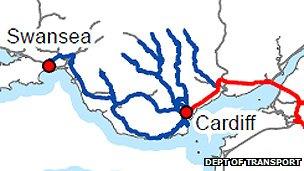Rail electrification to Swansea and south Wales valleys welcomed
- Published
Planned rail electrification has been hailed as the biggest investment in trains in Wales for more than a century and a major boost for passengers and business.
The UK government says its extension of electrification of the network to Swansea and the valleys will bring faster journeys and promote jobs.
The Welsh secretary said the direct investment is worth £350 million.
Ministers say it will help people get to work, and bring cleaner travel.
Work on electrification is expected to start sometime between 2014 and 2019, but the industry will determine the exact timetable "in due course", said the Department of Transport.
The UK government agreed last year to electrify the line as far west as Cardiff, and had faced heavy lobbying to extend the investment to Swansea.
The Department of Transport said Monday's announcement followed "detailed discussions" with the Wales Office and the Welsh government.
Transport Secretary Justine Greening MP said: "This will give two-thirds of the Welsh population access to new fleets of electric trains helping to generate Welsh jobs and growth by slashing journey times and boosting passenger and freight capacity."
The south Wales valleys and commuter lines to be electrified will include Ebbw Vale, Maesteg and the Vale of Glamorgan.
The investment will also fund smaller schemes improving access at stations, the freight network and passenger journey times.

The electrification will now involve the main line to Swansea and the south Wales valley lines
Mrs Gillan welcomed the decision as "the most significant infrastructure announcement for Wales for decades."
She said: "It will see over £350 million directly invested into the Welsh railway infrastructure, and arrives on the back of the £1 billion investment into the electrification of the Great Western Mainline from London to Cardiff, and the £500 million investment into the western link to Heathrow.
"In total, Wales is set to benefit directly and indirectly from almost £2 billion from the UK government programme to modernise the rail network, and is the most significant infrastructure announcement for Wales for decades."
First Minister Carwyn Jones said he was "delighted" at the move which he said would strengthen the east-west economic corridor and enhance Swansea's role as an economic hub.
"Investing in our transport infrastructure is vital as we look to improve the economic competitiveness of Wales," said Mr Jones.
Welsh Transport Minister Carl Sargeant said the move would boost the mobility of valleys-based communities, and widen the employment catchment area for businesses looking to invest in the region.
"An electrified rail network is more economical to operate and maintain which will deliver value for money to the taxpayer," said Mr Sargeant.
"Passengers will travel in a more environmentally sustainable way and experience a quieter, faster journey with savings of up to 20% on existing timetables."
Mark Langman, Network Rail's route managing director for Wales, said the electrification of the Valley lines network would help unlock the economic potential of the region.
"This is a strong vote of confidence in the railway, and in our ability to deliver sustainable economic growth through development of, and investment in, the network," he said.
Mark Barry, a business consultant who wrote the South Wales metro report making the case for improved connectivity to help the economy, told BBC Radio Wales that Monday's announcement would provide a huge foundation for a radical change in Wales' economic performance.
"It's probably the most significant investment in Welsh rail since the Severn tunnel was opened," said Mr Barry.
The tunnel was built in the late 19th Century, and completed in the mid-1880s.
Extending the electrification of the main rail line will cut some 20 minutes from the three-hour journey between Paddington and Swansea.
As well as cutting journey times, the decision to electrify the main line to Swansea means newer, longer trains will be able to run on the line, powered by overhead cables.
The new trains will have nine carriages instead of the current eight, allowing more passengers to be carried on the line.
The Department of Transport announcement for south Wales involves overhead electrification of the following lines:
Cardiff Central to Cardiff Queen Street
Cardiff Queen Street to Aberdare
Cardiff Queen Street to Cardiff Bay
Cardiff Queen Street to Coryton
Newport to Ebbw Vale
Cardiff Central to Maesteg via Pontyclun, Bridgend
Abercynon to Merthyr Tydfil
Grangetown to Penarth
Cardiff Central to Danescourt via Radyr (City Line)
Cardiff Queen Street to Rhymney
Pontypridd to Treherbert
Cardiff Central to Bridgend via Barry - Bridgend (Vale of Glamorgan)
Barry to Barry Island
Bridgend to Swansea
The decision comes after a week after the go-ahead was given to a £500m rail link to Heathrow.
From 2021 passengers from south Wales, the west of England and the Thames Valley on the Great Western main line will no longer need to travel to the airport via Paddington.
- Published16 July 2012
- Published16 July 2012
- Published16 July 2012
- Published13 July 2012
- Published12 July 2012
- Published23 May 2012
- Published11 May 2012
- Published11 March 2012
- Published24 June 2011
- Published1 March 2011